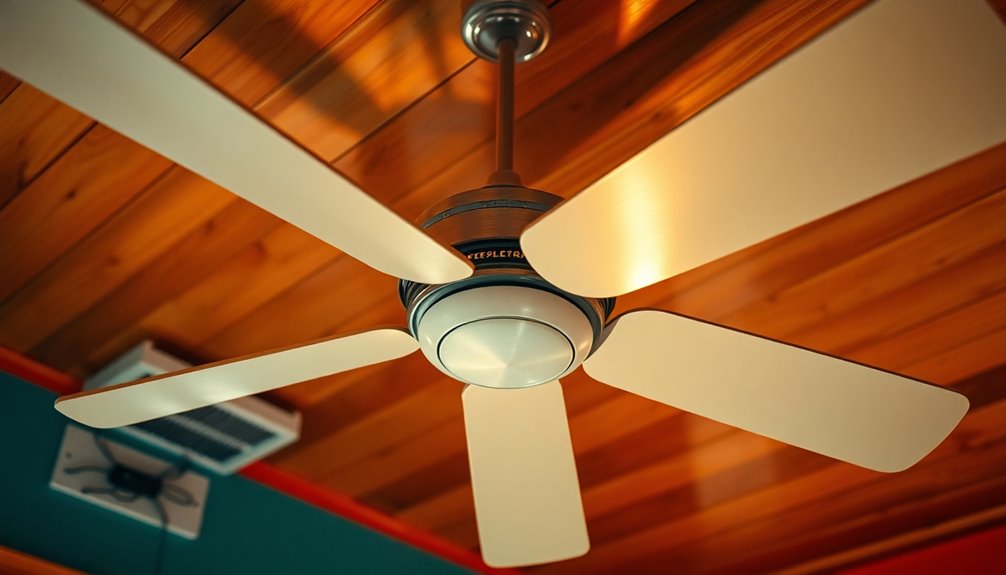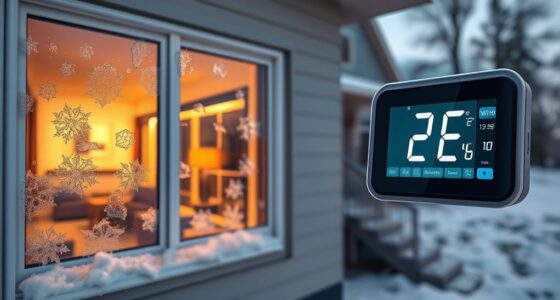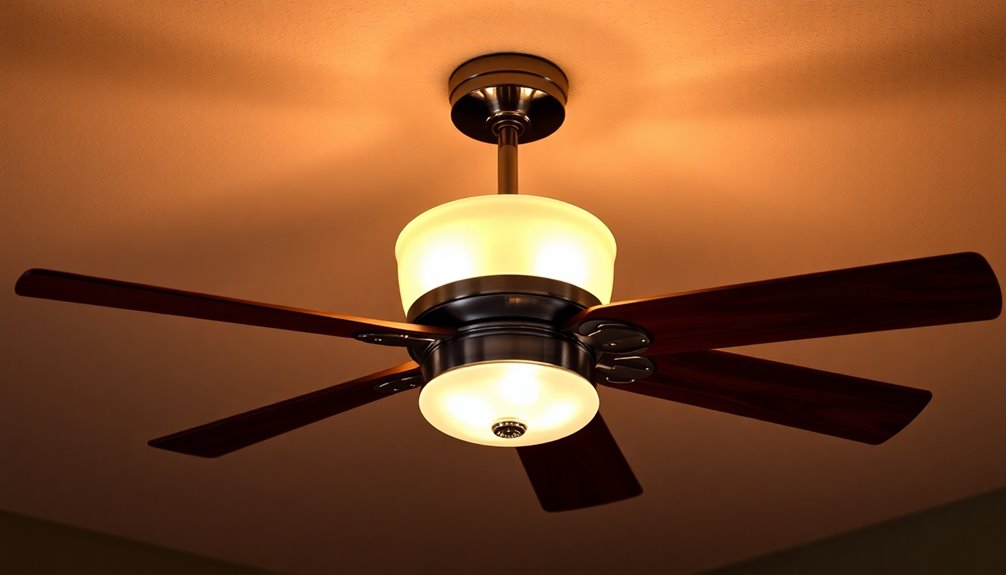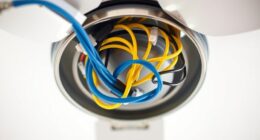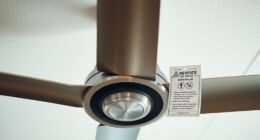You can safely connect 3 to 4 ceiling fans on a 15 amp circuit to avoid tripping breakers and guarantee proper functioning. While the theoretical maximum allows for many fans, each ceiling fan typically draws between 0.5 to 1.2 amps when running. This means too many fans can lead to an overload. It's best to evaluate the total wattage of all devices on the circuit, including lights. Choosing energy-efficient fans can also help. If you'd like to know more about safe installation and energy-saving tips, there's plenty to explore that can enhance your comfort and efficiency.
Key Takeaways
- A 15 amp circuit can support a maximum continuous load of 12 amps, equating to 1440 watts at 120 volts.
- Standard ceiling fans typically consume 70-100 watts, allowing for 10-12 fans on a circuit under ideal conditions.
- Consider startup currents, which can be 2-3 times higher, limiting practical fan connections to 3-4 per circuit.
- ENERGY STAR® ceiling fans are more efficient, using only 48-52 watts, potentially allowing up to 12 fans on a 15 amp circuit.
- Always account for additional lights and devices on the same circuit to avoid overload and ensure safety.
Understanding Ceiling Fan Amperage
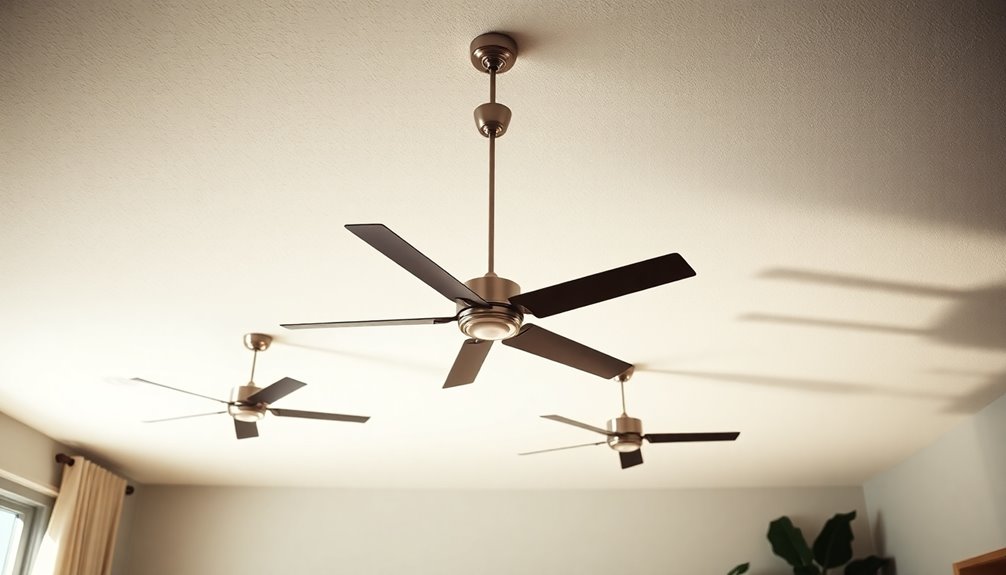
When you're considering how many ceiling fans you can run on a 15 amp circuit, it's important to understand their amperage draw. The average current draw for a ceiling fan typically ranges from 0.2 to 1.5 amps, depending on factors like fan size and type. Most standard ceiling fans draw about 0.5 to 1.2 amps when operating at high speed, allowing you to connect multiple fans to a single circuit.
A 15 amp circuit can handle a maximum continuous load of 12 amps. This means you could theoretically support up to 24 fans if each one draws around 0.5 amps. However, practical limitations and safety considerations should lead you to reduce this number.
Another vital aspect to remember is the startup current. Ceiling fans often draw 2-3 times their normal running amperage at startup, which can greatly impact how many fans can safely operate on one circuit.
Calculating Circuit Capacity
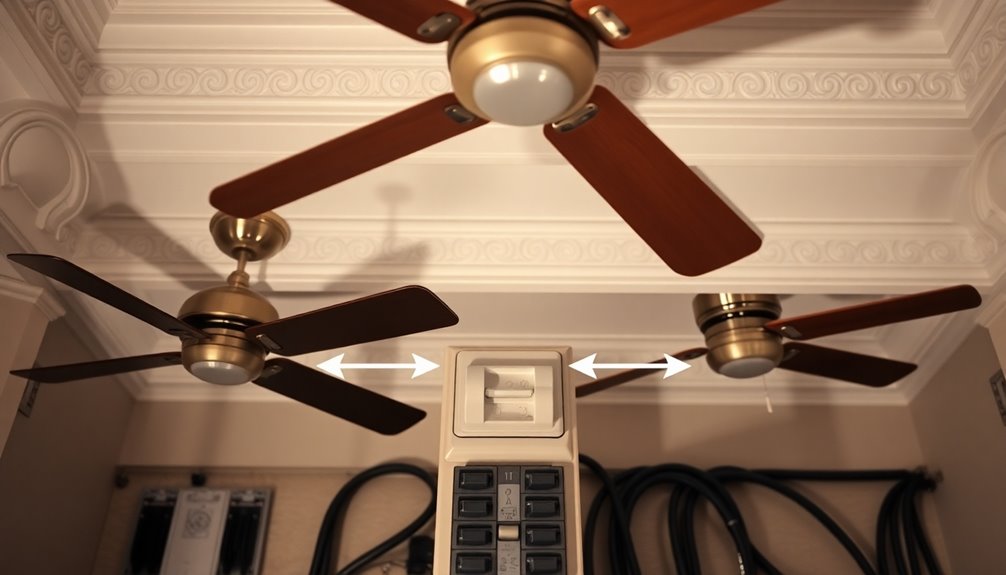
To determine how many ceiling fans you can safely operate on a 15 amp circuit, you'll need to calculate the circuit's capacity. A standard 15 amp circuit can deliver up to 1800 watts at 120 volts.
However, for continuous loads, it's wise to limit usage to 80% of the circuit capacity, which means you should stick to 12 amps or 1440 watts.
Next, consider the amperage each ceiling fan draws. Typically, fans use between 0.5 to 1.5 amps, depending on the model and speed setting.
For example, if you choose fans that draw around 0.5 amps, you could potentially connect up to 24 fans (12 A ÷ 0.5 A). But if each fan consumes about 70 watts, then 10 fans would only use around 700 watts, keeping you well within the 1440-watt limit.
Don't forget to factor in any additional devices on the same circuit, as they contribute to the overall load and can reduce the number of ceiling fans you can safely operate.
Always prioritize safety when calculating your circuit capacity.
Types of Ceiling Fans
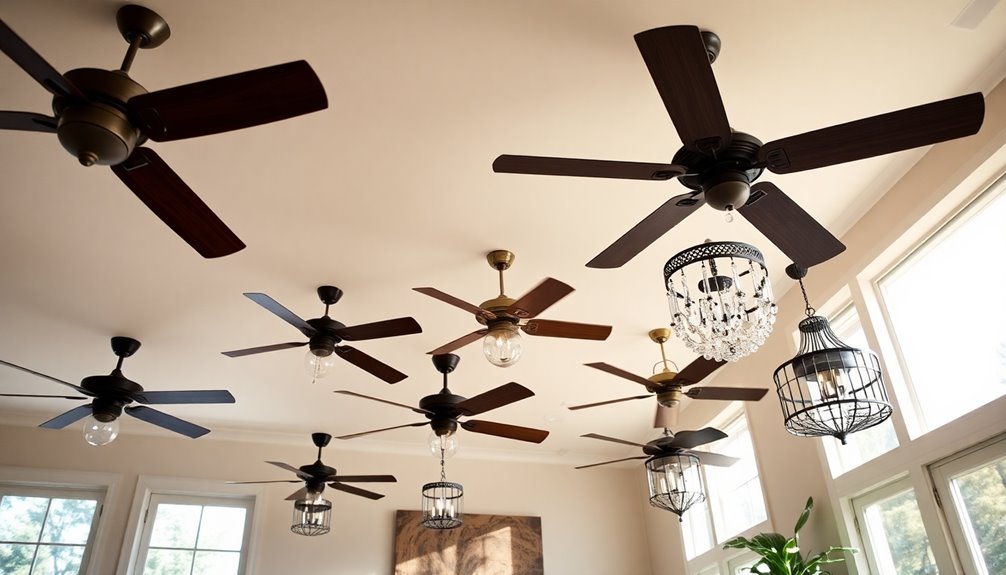
Ceiling fans come in various types, each designed to meet specific needs and preferences. Standard ceiling fans, with a blade span of 42 to 60 inches, draw between 70 to 100 watts of power, making them ideal for average-sized rooms. These fans can significantly reduce energy consumption in conjunction with air conditioning systems. Additionally, using a properly sized fan can enhance heat transfer efficiency by promoting better airflow throughout the space. Moreover, many of these fans are designed with advanced filtration systems that improve indoor air quality while circulating air.
If you have low ceilings, you might opt for flush mount fans, which operate at lower wattages of around 40 to 60 watts. Hugger fans are similar and provide efficient airflow in tight spaces, typically consuming 50 to 70 watts. Proper installation of these fans ensures that they operate quietly and efficiently, enhancing overall comfort.
For outdoor spaces, you'll need outdoor ceiling fans, which can handle moisture and usually operate at higher wattages, ranging from 60 to 120 watts. These fans are designed with innovative features to ensure durability and performance in various weather conditions.
If you're tech-savvy, smart ceiling fans are an excellent choice. These energy-efficient options use only 28 to 35 watts of power and offer remote control and automation features, promoting significant energy savings. Additionally, incorporating energy-efficient technology into your ceiling fan choices can further enhance your energy savings and overall comfort.
When planning your ceiling fan installation, consider how many fans you can connect to your amp breaker. Each fan's wattage will affect your total load, so choose the right type to guarantee efficient operation without exceeding your circuit's capacity. Understanding the power requirements of your selected fans will help ensure a safe and effective setup.
Load Management Strategies
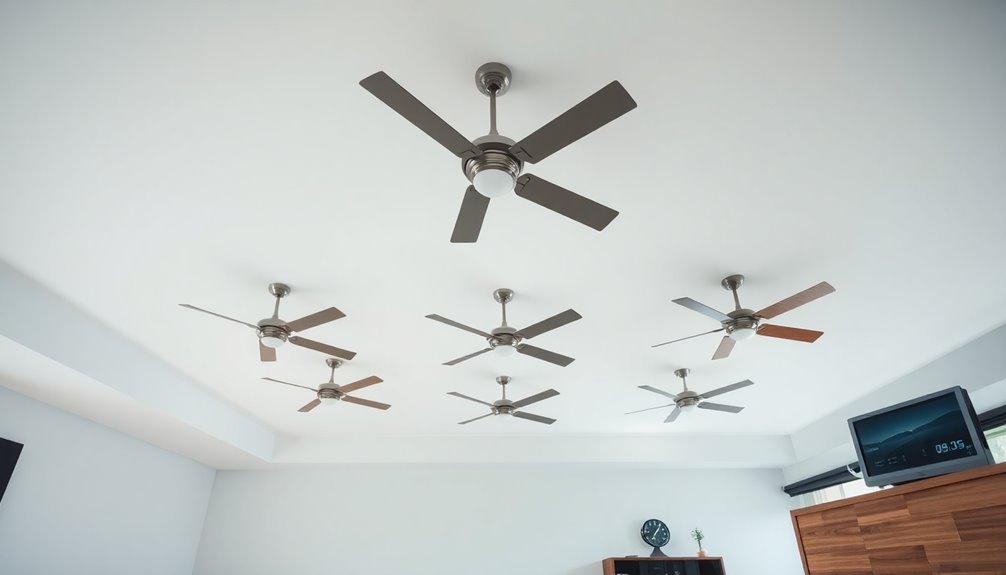
Effective load management strategies are essential for ensuring the safe operation of ceiling fans on a 15 amp circuit. To maximize safety and efficiency, you'll want to keep the total load within the circuit capacity. Here are three key strategies to help you manage your load effectively:
- Calculate Total Wattage: Make sure to take into account the wattage of each ceiling fan and any attached lights. For example, if a fan uses 75 watts and you plan to install 10 fans, your total would be 750 watts, which is well within the safe limit.
- Limit Fan Count: Since each ceiling fan typically draws between 0.5 to 1.5 amps, you can safely connect approximately 7 to 12 fans. Always check the specific amperage draw of your fans to avoid exceeding the recommended load.
- Monitor for Overload Signs: Keep an eye out for flickering lights or tripped breakers, as these can indicate you're approaching the circuit's capacity. If you notice these signs, reduce the number of ceiling fans or think about using energy-efficient models to lighten the load. Additionally, maintaining good indoor air quality can enhance the overall comfort of your living space while managing electrical loads effectively.
Energy Efficiency Tips
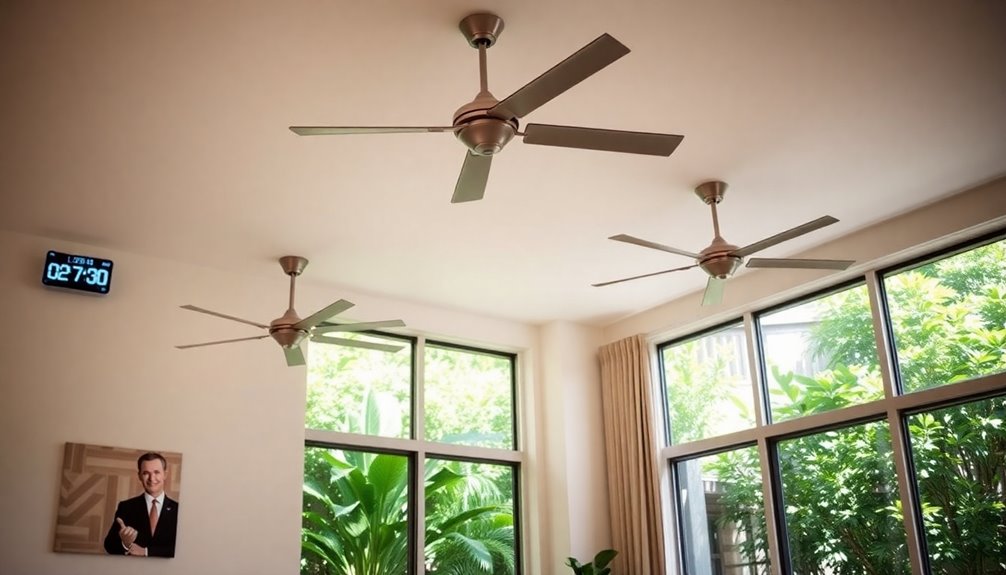
To maximize energy efficiency with your ceiling fans, start by optimizing their placement throughout your home. Consider investing in ENERGY STAR models, which can save you up to 40% on electricity bills. Additionally, utilizing geothermal heat pumps can further enhance your home's energy efficiency by reducing reliance on traditional cooling systems. Heat pumps can achieve efficiencies of 300-600%, resulting in significant energy savings. Furthermore, implementing a retirement savings plan allows you to allocate funds for home improvements, contributing to long-term financial stability. Finally, don't forget to adjust your thermostat settings to enjoy even greater savings while keeping comfortable. Additionally, using best airflow ceiling fans can help to circulate air more effectively, enhancing overall comfort and reducing energy costs. Incorporating air purifiers into your space can also improve indoor air quality, making your home a healthier environment while you save on energy costs.
Optimize Fan Placement
How can you enhance your home's energy efficiency with fan placement? Properly positioning your ceiling fans can greatly reduce your reliance on air conditioning and lower your energy bills. Here are three tips to optimize fan placement:
- Height Matters: Install ceiling fans at least 8 feet above the floor. This height maximizes airflow and cooling effectiveness, ensuring you get the most from your fans.
- Choose the Right Size: Use larger blade fans in spacious rooms. They provide lower velocity cooling efficiency, making them more effective than smaller fans in larger areas.
- Mind the CFM: Consider the CFM (cubic feet per minute) rating of your ceiling fans. Higher CFM ratings indicate better airflow, which is essential for effective cooling and energy efficiency.
Additionally, adjust your fan speeds according to the season—use counter-clockwise rotation for cooling in the summer and clockwise for circulating warm air in winter.
This simple adjustment can improve your overall heating efficiency while keeping your branch circuits running smoothly. By optimizing fan placement, you're taking a considerable step toward increased energy efficiency in your home.
Use Energy Star Models
When you choose ENERGY STAR® ceiling fans, you're not just making a stylish addition to your home; you're also making a smart investment in energy efficiency.
These fans typically use only 48-52 watts, or about 0.4 amps, which means you can connect more of them to a 15 amp circuit compared to conventional models. This allows you to run approximately 12 ENERGY STAR® ceiling fans safely on a single circuit, maximizing your cooling potential in large spaces.
By opting for ENERGY STAR® fans, you can enjoy energy savings of up to 40% compared to standard ceiling fans. This translates to lower electricity bills while still keeping your home comfortable.
Additionally, installing multiple ENERGY STAR® ceiling fans helps distribute air evenly throughout your space, reducing your reliance on air conditioning.
With this energy-efficient approach, you'll not only enhance comfort but also contribute to a more sustainable lifestyle.
Adjust Thermostat Settings
Adjusting your thermostat settings can lead to noticeable energy savings while keeping your home comfortable. By making a few simple changes, you can greatly reduce your cooling costs and improve energy efficiency. Here are some tips to get you started:
- Raise Your Thermostat: Consider raising your thermostat by 4°F while using two ceiling fans. This can cut your air conditioning usage by up to 15%, saving you money on your electricity bill. Additionally, maintaining a decluttered environment can help you feel more at ease, allowing you to enjoy your home even more.
- Utilize Ceiling Fans Effectively: Make sure your ceiling fans are set to rotate counterclockwise in the summer to create a wind-chill effect, helping you feel cooler without over-relying on air conditioning.
- Install Ceiling Fans in Every Room: Doing so can help maintain consistent temperatures throughout your home, reducing the need for excess cooling on one circuit and enhancing overall comfort.
Additionally, remote work can benefit from a more energy-efficient home environment, making it easier to focus and stay productive.
Wiring and Safety Considerations
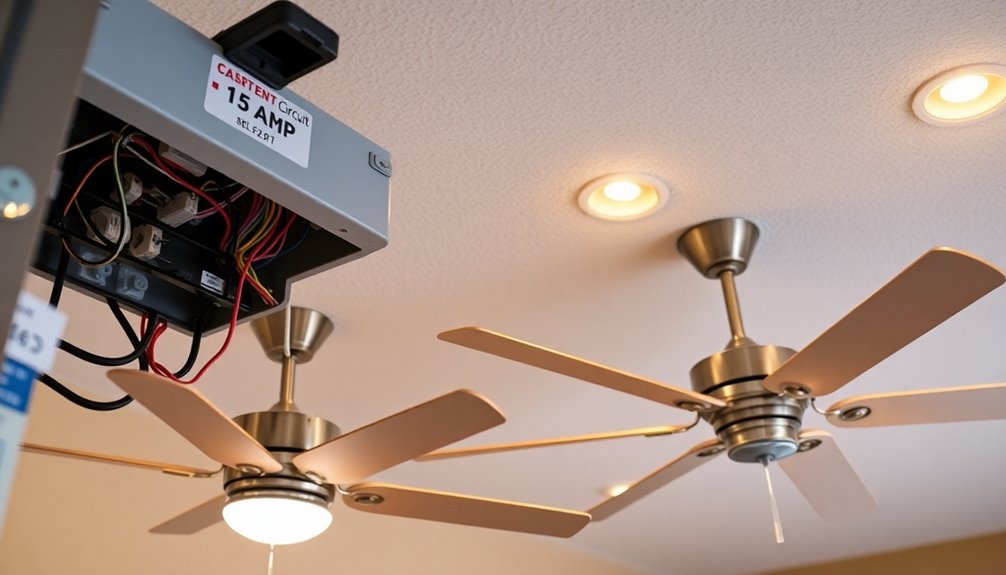
When wiring ceiling fans on a 15 amp circuit, you need to pay close attention to circuit load limits.
To stay safe, aim to keep your load at 80% or less, which means you should account for any additional lights or devices on the same circuit.
Also, using the correct wire gauge, like 14 AWG, is essential to prevent overheating and guarantee proper function.
Circuit Load Limits
Understanding circuit load limits is essential for guaranteeing safety and efficiency in your electrical system. A 15 amp circuit can safely handle a maximum continuous load of 12 amps, which is 80% of its total capacity. This precaution prevents overheating and potential fire hazards.
When it comes to ceiling fans, they typically draw between 0.5 to 1.5 amps during operation. Here are some key considerations:
- Maximum Fans: If each ceiling fan uses about 1 amp, you could theoretically connect up to 12 fans. However, that doesn't account for additional devices or inrush current during startup.
- Wattage Limit: The total wattage on a 15 amp circuit at 120 volts shouldn't exceed 1800 watts, making careful load calculations essential.
- Practical Recommendations: To avoid tripping breakers and guarantee reliable operation, it's advisable to limit the number of ceiling fans to 3-4 on a single 15 amp circuit.
Wiring Gauge Recommendations
Choosing the right wiring gauge is vital for maintaining safety and efficiency in your ceiling fan installations. For a 15 amp circuit, the standard practice is to use 14 AWG wire. This gauge can safely handle the maximum current without overheating, guaranteeing your ceiling fan operates smoothly.
If you're planning to heavily load the circuit or use it for continuous duty, consider upgrading to 12 AWG wire. This gauge not only provides a greater safety margin but also helps reduce voltage drop, which can be significant for performance.
Remember, electrical codes often state that the maximum continuous load on a 15 amp circuit shouldn't exceed 80% of its capacity—this means you should keep it under 12 amps.
Since each ceiling fan typically draws between 0.5 to 1.5 amps, you can install multiple fans on a single circuit as long as the total amperage remains within this safe limit.
Frequently Asked Questions
How Many Ceiling Fans With Lights Can Be on a 15 Amp Circuit?
When you're planning to install ceiling fans with lights, it's important to take into account the circuit's capacity.
Typically, each fan draws between 0.5 to 1.5 amps. If you're including lights, you'll want to keep the total load under 12 amps for safety.
How Many Amps Does the Average Ceiling Fan Draw?
The average ceiling fan draws between 0.2 to 1.5 amps, depending on its size and type.
Most standard fans typically consume around 0.6 to 0.8 amps, while larger models can pull 0.7 to 1.2 amps due to higher power needs.
If you're considering a smart ceiling fan, expect it to use only about 0.2 to 0.3 amps, making it an energy-efficient option.
What Is the Maximum Devices on a 15 Amp Circuit?
You might think you can power a small army of devices on a 15 amp circuit, but hold on! The maximum number of devices really depends on what you're plugging in.
Generally, you shouldn't exceed 12 amps for safety, which means you can connect several devices, but you'll need to count their wattage.
Keep track of everything; it's vital to avoid tripping breakers or risking electrical issues in your space!
Can I Run Two Ceiling Fans on One Circuit?
Yes, you can run two ceiling fans on one circuit, but you need to be cautious.
Make sure their combined current draw stays below 12 amps to avoid overloading the circuit. Most fans draw between 0.5 to 1.5 amps each, so check the specs.
If you're adding lighting or other devices to the same circuit, factor in their wattage too.
It's all about keeping within the safe limits for your circuit.
Conclusion
In the dance of air and light, your ceiling fans can whirl gracefully on a 15 amp circuit, but it's crucial to know their limits. Like a well-choreographed ballet, balance is key—typically, you can safely install up to three fans. By managing their load and embracing energy efficiency, you guarantee a harmonious atmosphere in your home. So, let your ceiling fans spin freely, but remember: a little caution keeps the rhythm just right.
